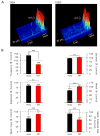Flecainide inhibits arrhythmogenic Ca2+ waves by open state block of ryanodine receptor Ca2+ release channels and reduction of Ca2+ spark mass
- PMID: 19835880
- PMCID: PMC2813417
- DOI: 10.1016/j.yjmcc.2009.10.005
Flecainide inhibits arrhythmogenic Ca2+ waves by open state block of ryanodine receptor Ca2+ release channels and reduction of Ca2+ spark mass
Abstract
Catecholaminergic polymorphic ventricular tachycardia (CPVT) is linked to mutations in the cardiac ryanodine receptor (RyR2) or calsequestrin. We recently found that the drug flecainide inhibits RyR2 channels and prevents CPVT in mice and humans. Here we compared the effects of flecainide and tetracaine, a known RyR2 inhibitor ineffective in CPVT myocytes, on arrhythmogenic Ca(2+) waves and elementary sarcoplasmic reticulum (SR) Ca(2+) release events, Ca(2+) sparks. In ventricular myocytes isolated from a CPVT mouse model, flecainide significantly reduced spark amplitude and spark width, resulting in a 40% reduction in spark mass. Surprisingly, flecainide significantly increased spark frequency. As a result, flecainide had no significant effect on spark-mediated SR Ca(2+) leak or SR Ca(2+) content. In contrast, tetracaine decreased spark frequency and spark-mediated SR Ca(2+) leak, resulting in a significantly increased SR Ca(2+) content. Measurements in permeabilized rat ventricular myocytes confirmed the different effects of flecainide and tetracaine on spark frequency and Ca(2+) waves. In lipid bilayers, flecainide inhibited RyR2 channels by open state block, whereas tetracaine primarily prolonged RyR2 closed times. The differential effects of flecainide and tetracaine on sparks and RyR2 gating can explain why flecainide, unlike tetracaine, does not change the balance of SR Ca(2+) fluxes. We suggest that the smaller spark mass contributes to flecainide's antiarrhythmic action by reducing the probability of saltatory wave propagation between adjacent Ca(2+) release units. Our results indicate that inhibition of the RyR2 open state provides a new therapeutic strategy to prevent diastolic Ca(2+) waves resulting in triggered arrhythmias, such as CPVT.
Copyright 2009 Elsevier Ltd. All rights reserved.
Conflict of interest statement
Disclosure Statement: The authors declare no conflict of interest
Figures






Comment in
-
An antidote for calcium leak: targeting molecular arrhythmia mechanisms.J Mol Cell Cardiol. 2010 Feb;48(2):279-82. doi: 10.1016/j.yjmcc.2009.11.005. Epub 2009 Nov 26. J Mol Cell Cardiol. 2010. PMID: 19931542 No abstract available.
References
-
- Nabauer M, Callewaert G, Cleemann L, Morad M. Regulation of calcium release is gated by calcium current, not gating charge, in cardiac myocytes. Science. 1989 May 19;244(4906):800–3. - PubMed
-
- Bers DM. Calcium fluxes involved in control of cardiac myocyte contraction. Circ Res. 2000 Aug 18;87(4):275–81. - PubMed
Publication types
MeSH terms
Substances
Grants and funding
LinkOut - more resources
Full Text Sources
Other Literature Sources
Medical
Research Materials
Miscellaneous

